Biden’s Plan for Supreme Court Reform: What It Means and Who It Affects
President Joe Biden has introduced a plan to reform the Supreme Court. This plan could change the way the court works and who benefits from it. Let’s take a closer look at what this reform entails and who it might impact.
What Is the Reform About?
Biden’s plan includes several key changes to the Supreme Court:
- Increasing the Number of Justices: One idea is to increase the number of justices on the court. This would mean more people deciding on important cases.
- Term Limits: Another proposal is to set term limits for justices. Currently, justices serve for life unless they choose to retire. Term limits would mean justices serve for a fixed number of years.
- Ethics Rules: Biden also wants to enforce stricter ethics rules for justices. This could involve more transparency about their financial interests and behavior.
Why Is This Important?
The Supreme Court is the highest court in the United States. It makes decisions that affect everyone. These decisions can shape laws on issues like healthcare, education, and civil rights. Changing the way the court works could have a big impact on these decisions.
Who Benefits from the Reform?
- The General Public: With more justices, there could be a wider range of viewpoints. This could lead to fairer and more balanced decisions. Term limits could ensure that new ideas and perspectives regularly enter the court.
- Democrats: Since Biden is a Democrat, many believe that adding more justices could help ensure that the court reflects more liberal views. This could be seen as a way to counter the current conservative majority on the court.
Who Could Be Hurt by the Reform?
- Current Justices: Justices who were appointed for life might not welcome the idea of term limits. They might feel that their job security and independence are being threatened.
- Republicans: Many Republicans see this reform as an attempt to undermine the conservative majority on the court. They argue that it could lead to a more politically biased court, depending on who gets to appoint the new justices.
Does It Give a Political Advantage?
Yes, the reform could give a specific political party an advantage. If the number of justices is increased while a Democrat is in office, more liberal justices might be appointed. This could tilt the court in favor of Democratic policies. Conversely, if a Republican were president, they could appoint more conservative justices, maintaining or strengthening the conservative majority.
Potential Controversies
- Politicization of the Court: Critics argue that changing the number of justices could make the court more political. They worry that each party might try to increase the number of justices whenever they are in power, leading to instability.
- Legal Challenges: Any changes to the structure of the Supreme Court could face legal challenges. Opponents might argue that these changes are unconstitutional and take the issue to court.
Biden’s Supreme Court reform is a significant proposal that could reshape the highest court in the land. It aims to bring more balance and accountability to the court but comes with its share of controversies. The impact of this reform will depend on how it is implemented and the political landscape at the time. As with any major change, there are potential benefits and drawbacks, and it is essential to consider all sides of the issue.
In summary, this reform has the potential to benefit the public by creating a fairer and more balanced court. However, it also poses challenges and risks, particularly regarding the court’s independence and potential politicization. The debate over this proposal is likely to continue, with strong arguments on both sides.


